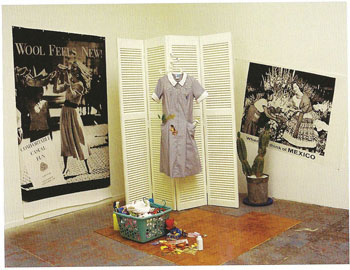II. Latina Working Women's Radical Resilience
- Sage Gaspar
 Figure 6
Figure 6
Women’s Work is Never Done (1995), a silkscreen print compiled from multiple images, captures Latina women’s resilience bursting through as they reclaim the square frame (fig. 6). In this print Yolanda M. López challenges the gendered stereotypes of Latina women, specifically working class women. By reworking two found images, she creates a hybrid perspective of intergenerational female strength that celebrates the iconography of social activist Dolores Huerta, while simultaneously highlighting the tenacity of women laborers from California.
A photograph of a young Dolores Huerta holding a protest sign taken in 1965 hangs in the top left corner of the print. Huerta was the co-founder of the United Farm Workers agricultural labor union which organized historical activism advocating for the rights of predominantly Latinx and Filipino agricultural workers. She got into activism because she was an agricultural labor worker herself, as well as a young mother who was struggling to support her family through the unjust conditions of agricultural work at the time. She has dedicated her life to fighting not only for the rights of labor workers but also specifically for the gendered rights of women and mothers. In the print, Huerta is grey and faded, representing a spirit looking over the women workers in front of her. Her protest sign is cut off by the white frame but the word HUELGA, which is Spanish for strike, can still be read along with the logo for the United Farm Workers Union logo. HUELGA became the slogan for the UFW movement because organizing large nation-wide strikes was one of their main modes of activism.
A second image layered on top of the Huerta photograph features women workers from a broccoli farm in California taken 30 years after the Dolores Huerta image in 1995. In contrast to the monotone of the Huerta image, the women are printed in bright, popping colors. Three of the four women’s mouths are covered with bandanas. Besides being a necessary method of protection during work, it also embodies the way that immigrant women workers are expected to be silent and tend to their labor. Despite this attempt to silence, the women stand strong, firmly gripping the white frame that encases the print, affirming their agency.
Agricultural workers are exposed to many dangers and are forced to work under harsh conditions. This print shifts the narrative that women stick to domestic work while their partners provide the financial resources. On the contrary, in households that depend on agricultural work as their main source of income not only do the women work but often the entire family, including children, work to provide for their families. Women are the matriarchs of their family who have to be their own advocates for equal rights while also working hard to support their families. The two images, taken thirty years apart, show that Huerta’s efforts during the UFW movement helped offset more than three decades worth of space for women workers to thrive. Huerta also created spaces for more just working and living conditions. However, that is not to say that total equity and justice for labor workers has been achieved. Extensive organizing and social activism through labor unions has brought justice a long way but there is still much more progress to be made in the efforts of providing living wages, healthy working conditions, and protective benefits for families to live safely.
The gaze of the woman worker at the forefront of the print is strong and she stares directly at the viewer. Her eyes project power and resilience. On the left text reads “homenaje a Dolores Huerta: 1965” which means “homage to Dolores Huerta” in Spanish. On the right there is another complementary line of text that reads “California Broccoli Harvest: 1995.” These lines of text offer an invitation to approach the print in a more didactic method while also physically naming the subjects of the print. To label the specific harvest and year signifies that these women might have been traveling workers who migrate throughout the year to follow available work. This would mean that they often have no permanent place of residence and survive by moving from one temporary space to another following the seasonal crops. The use of both English and Spanish is another example of juxtaposition found within that illustrates the concept of duality.
Duality is a Mesoamerican indigenous theoretical concept that honors the idea of balance such as the sun and moon, life and death, etc. It has been adapted as one of the main pillars in the foundation of Chicano identity. Duality can be seen many times throughout the composition of the print; the first instance being the duality of Dolores Huerta in contrast to the later generation of women workers represented through the contrast of color versus monotone.
 Figure 7
Figure 7
This print was created by Yolanda M. López in 1955 and it was part of a portfolio 10x10: Ten Women/Ten Prints which was originally published by the Berkeley Art Center in 1995 to commemorate that year’s International Women’s Day (March 8th) and the 75th anniversary of the adoption of the 19th amendment, which gave women in the U.S. the right to vote.1 Apart from being a multimedia artist, López is also an activist and scholar who has deeply connected her activist and academic work to her art practice. She grew up in San Diego, then moved up to the Bay Area where she participated in activism like the student strike at San Francisco State University in 1968, which influenced her to take up a conceptual art practice. López’s work focuses on domestic labor and the preponderance of racial and gender stereotypes in the media, and the realities of everyday life among Latina women.2 She analyzes influential iconography and offers a counter hegemonic standpoint. One of her most famous political posters was Who’s the Illegal Alien, Pilgrim? (1994) where an Aztec god is holding crumpled immigration papers and pointing his finger, in a version of the U.S. Army’s Uncle Sam icon (fig. 7).
 Figure 8
Figure 8
 Figure 9
Figure 9
In 2008, the Mission Cultural Center for Latino Arts in San Francisco held a retrospective exhibition featuring an overview of her work under the same name of this print, Women’s Work is Never Done. Women’s Work is Never Done is also the title of a larger series she created that includes The Nanny (1994), a mixed media installation that confronts the exploitation of female Latinx domestic workers, and Your Vote Has Power (1997), a silkscreen print that declares the power that mothers hold when engaging in voting (figs. 8 and 9). Your Vote Has Power and Women’s Work is Never Done are complementary prints that commemorate the change that Latinx women have accomplished by engaging their agency. López created many prints with the intent of creating accessible art that could be distributed widely to serve as socio-political didactic tools. I also wanted to add that upon my research I discovered that this print has a second title, Homenaje a Dolores Huerta, which is in relation to the original portfolio series that it belongs to.
 Figure 10
Figure 10
Another print from the 10x10: Ten Women/Ten Prints portfolio that is also featured in the Shifting Perspectives exhibition is a photograph titled Percenda taken by Ruth Morgan (fig. 10). This image comes from a series Ruth Morgan made of homeless children in New York City.3 In Percenda, Morgan looks at racism, femininity and power through the subject of a young black girl named Percenda standing in a classroom, a place of learning and confinement. The eyes of the young girl hold the strength and agency of women similar to the woman in the foreground of Women’s Work is Never Done. They also share confident yet confrontational postures that show they are overcoming their obstacles as women in societies that value them as vulnerable. The labor of women of color has always been exploited. Women have the power to change the world and fight hegemonic social standards that might oppress them, all we have to do is ignite our agency and challenge these oppressive systems.
- “10x10: Ten Women / Ten Prints,” Ulrich Museum of Art, Wichita State University. Accessed November 09, 2020. https://ulrich.wichita.edu/ulrich_exhibition/10-x-10-ten-women-ten-prints/. ↩
- “Yolanda López,” Hammer Museum. Accessed November 09, 2020. https://hammer.ucla.edu/radical-women/artists/yolanda-lopez. ↩
- “Percenda,” Ulrich Museum of Art, Wichita State University. Accessed November 09, 2020. https://ulrich.wichita.edu/ulrich_art_item/percenda/?collection_type=exhibition. ↩
| words